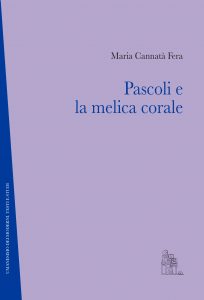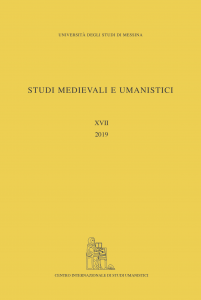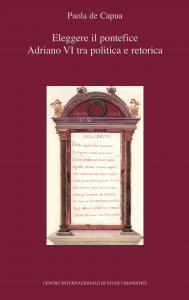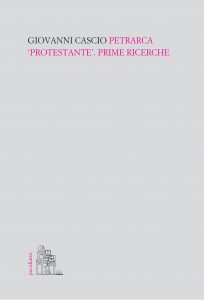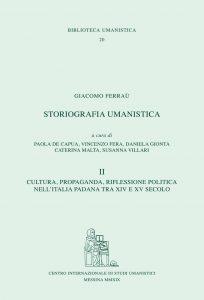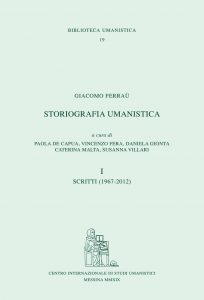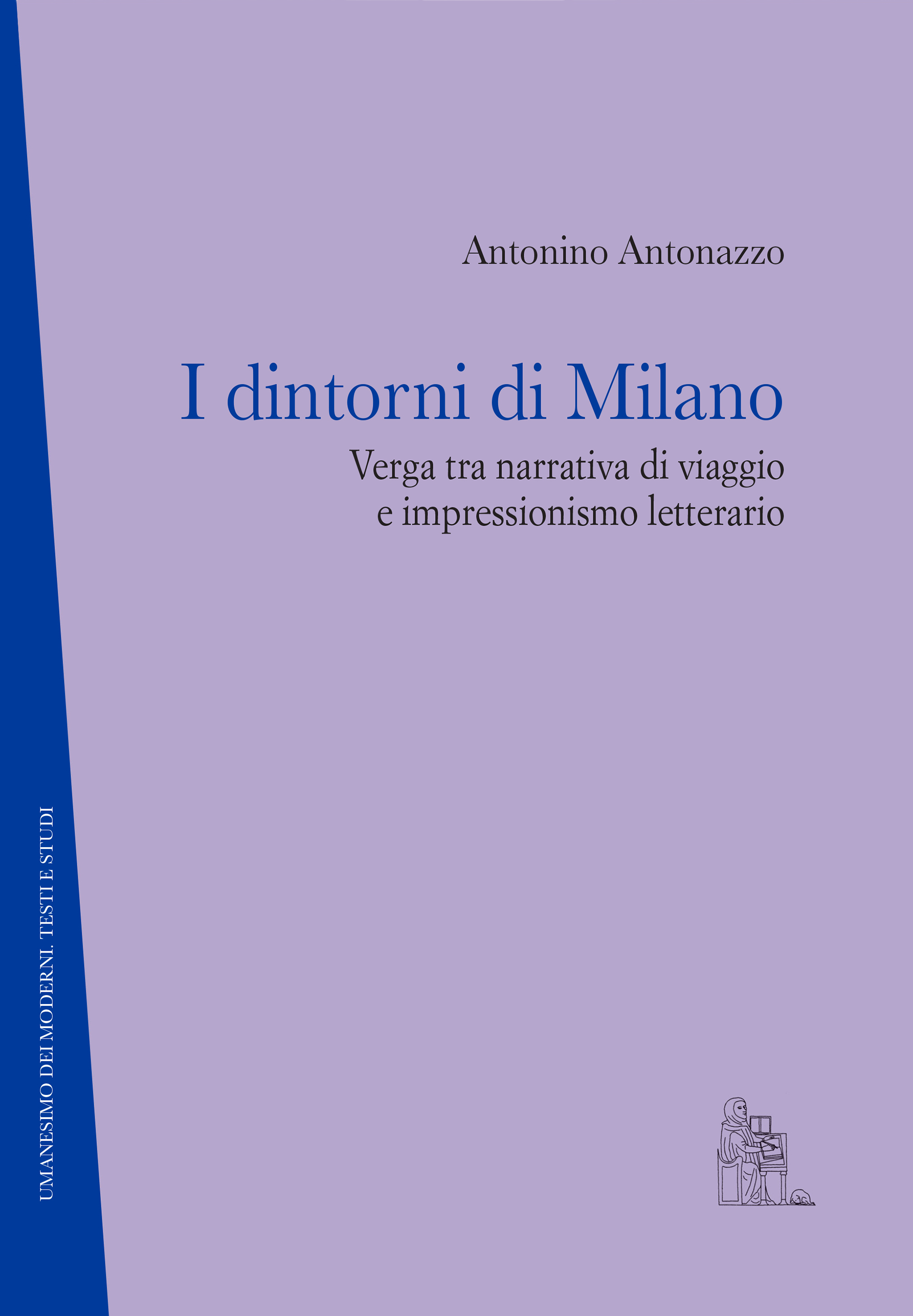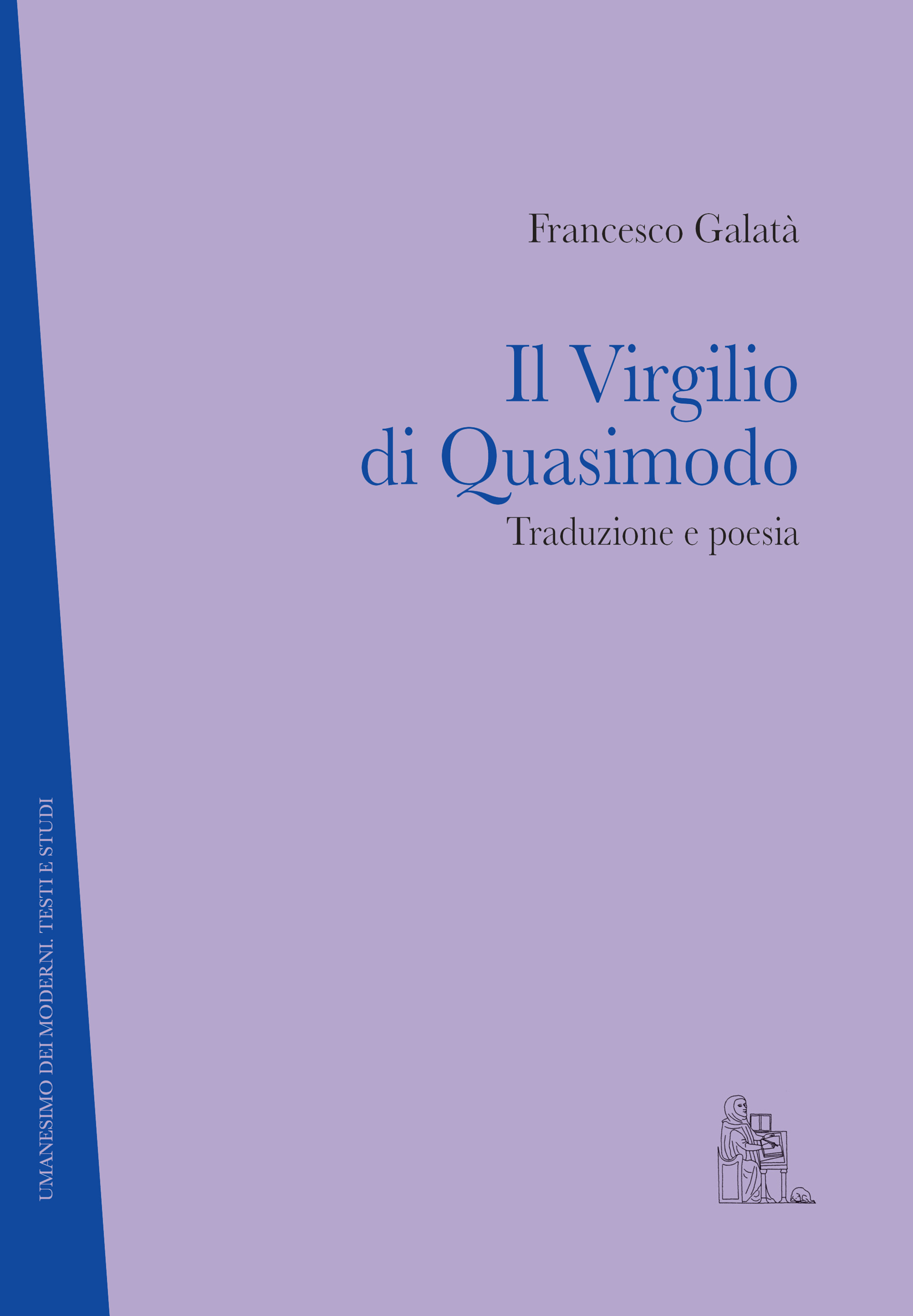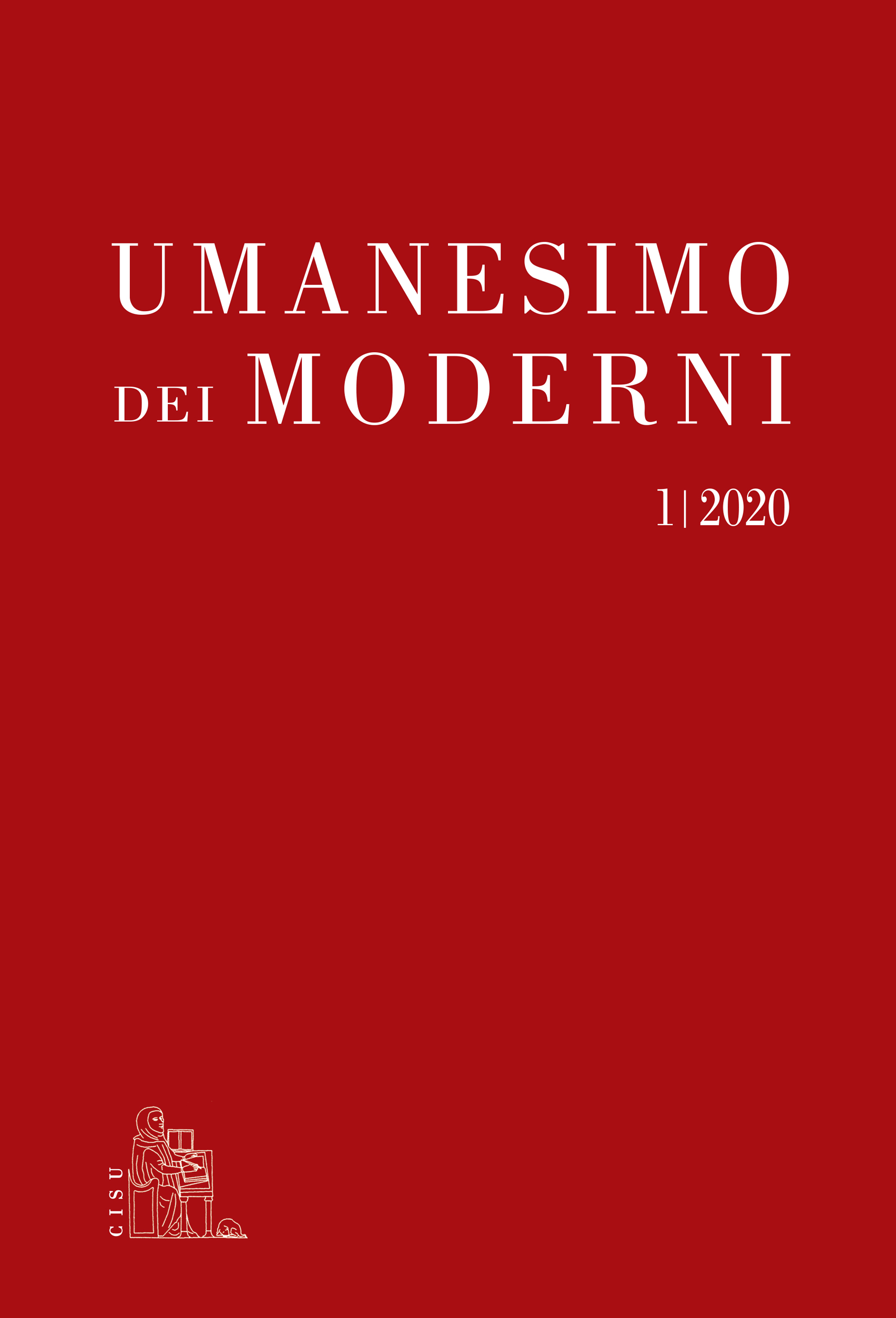
1 | 2020
Messina, Centro Internazionale di Studi Umanistici, 2020, 424 pp.; 25 cm.
ISSN 2724-0835
€ 80
INDICE GENERALE
Francesco Galatà, Nello studio del pittore Bersani. Dialoghi del giovane Pascoli sulle poetiche del secondo Ottocento
Claudia Castorina, Pascoli e i giudici di Amsterdam: il caso di Phidyle
Salvatore Guarino, Note su un’immagine visionaria in Pascoli: i rerum somnia di Myrmedon 61-64
Francesco Tripodi, L’Èra nuova di Giovanni Pascoli tra storia del testo e metrica neoclassica
Maria Cannatà Fera, «Inter odoratas Erycinae munera citros». Giovanni Pontano in Pascoli?
Sebastiano Valerio, «Rabbiosa fame» e «sacra fame». Dante, la lezione di Virgilio e l’esegesi di Pascoli
Sara Moscardini, Dalle carte alla rete. Gli archivi di Giovanni e Maria Pascoli
Antonino Antonazzo, Nell’officina del Verga novelliere: Il Carnevale tra Cavalleria rusticana e Nanni Volpe
Mario Strati, Giosue Carducci e Alberto Lumbroso. Carteggio
TESSERE
D. Gionta, Trafile redazionali di componimenti pre-miricei. Nuove testimonianze dal Fondo Ojetti
F. Galatà, Prima e dopo Regole e saggi di metrica neoclassica. Due appunti sugli esametri del Pascoli
D. Gionta, «Rubus fac ferat iste rosam». Tra Pascoli e Giovan Battista Giorgini
M. Cannatà Fera, Una singolare, dimenticata epigrafe di Giovanni Pascoli
Indice dei manoscritti e delle fonti d’archivio
Indice dei nomi
ABSTRACT
FRANCESCO GALATÀ, Nello studio del pittore Bersani. Dialoghi del giovane Pascoli sulle poetiche del secondo Ottocento
In the article the author recomposes the genetic relationships of some testimonies now disjointed to make out a textual system and an early Pascoli’s message of poetics. Specifically, it starts from a satirical journalistic prose (Nello studio del pittore Bersani. Impressioni), with a look at the relative handwritten answer (A proposito di un articolo della «Patria»), to discover the knots that unite it with other now unrelated testimonies (the ode Lesbo and the anepigraphic composition Tu siedi, o vecchio, e suoni al merlo il flauto). These are undoubtedly the strangest and most amazing Pascoli’s literary pieces, populated by ambiguous and anomalous figures and words. But the amazement does not last long when you think of them as products of a remote season of Pascoli’s life, the sense of estrangement disappears if you think them into their cultural context.
CLAUDIA CASTORINA, Pascoli e i giudici di Amsterdam: il caso di Phidyle
This paper focuses on a key element in the philological story of Phidyle, the Latin poem with which Giovanni Pascoli won the second of the thirteen gold medals at the Certamen Hoeufftianum for the year 1894: the close correspondence between the poet and the judges of the competition in the aftermath of the announcement of the victory. It’s a story not without repercussions on the textual structure of the poem and that, in the context of the questions posed by authorial philology, touches upon theoretical nodes of particular interest, such as the problem of forced drafting, the limit within which to frame the concept of last author’s will, the value of the vulgate.
SALVATORE GUARINO, Note su un’immagine visionaria in Pascoli: i rerum somnia di Myrmedon 61-64
The essay tries to define the exact meaning of somnia / rerum, a nexus in enjambement between the vv. 62-64 of Myrmedon, poetry in hexameters written by Giovanni Pascoli in 1994 and dedicated to the anatomy and behavior of ants. The nexus, a name followed by rerum (typical structure in the Pascoli’s latin), has been interpreted both as a subjective genitive and as an objective genitive. This essay reconstructs the genesis of the expression and recognizes it as an objective genitive; finally, the essay lingers on the origin of the strange images that complete the sequence.
FRANCESCO TRIPODI, L’Èra nuova di Giovanni Pascoli tra storia del testo e metrica neoclassica
The present essay proposes a collation between the text of the first printed edition of Giovanni Pascoli’s lecture L’Èra nuova, given in Messina on February 1899, and the text of the sections of the speech reported by the newspaper «Gazzetta di Messina» on the basis of notes provided by Pascoli himself. Besides, it offers a detailed prosodic and metrical analysis of two translations from the Iliad included inside the speech, comparing them with posterior versions of the same translations, to verify the connection between the author’s different choices in translating from ancient Greek and the progressively increasing observance of metrical principles and rules expounded in his Lettera al Chiarini and Regole di Metrica Neoclassica.
MARIA CANNATÀ FERA, «Inter odoratas Erycinae munera citros». Giovanni Pontano in Pascoli?
At the end of 1897, while waiting to take up the Latin Literature Chair at the University of Messina, Pascoli receives a sonnet invitation by Luigi Alessandro Michelangeli, who taught Greek Literature at that University. The poet responded through a brief elegy, in which he draws on Helena’s Palinode by Stesichorus, which had been translated and commented on by Michelangeli. Pascoli hopes for the Greek poet’s motherland, Imera, to welcome them both «inter odoratas, Erycinae munera, citros, | Elysium quoddam per nemus».The citrus trees (orange rather than citron trees) being qualified as ‘Venus Erycina’s gifts’ can be explained in light of a myth retold by Ioannes Pontanus: the goddess had transformed the body of her beloved Adonis into a tree after his death. The actual possibility that Pascoli drew directly on the humanist poet is validated by the shared feature of the otherworldly setting. The finding of a draft of the elegy contributes to interpret correctly some unclear lines.
SEBASTIANO VALERIO, «Rabbiosa fame» e «sacra fame». Dante, la lezione di Virgilio e l’esegesi di Pascoli
This essay wants to study the cant I of Dante’s Inferno and in particular the episode of the three fairs in the light of Giovanni Pascoli’s analysis. Pascoli particularly highlighted the role of the «lupa» and the meaning of «rabbiosa fame». The reading of the passage, which made use of classical and medieval intertexts, had a long exegesis in the modern age, which contributed to widening this reading to other places and episodes of the poem, in which the narrative events took on a profound metapoetic sense, which was well understood by Pascoli himself, who made it a central point of reference in his idea of poetry.
SARA MOSCARDINI, Dalle carte alla rete. Gli archivi di Giovanni e Maria Pascoli
Over the years, Giovanni Pascoli’s archive has been object of different interventions which gave it the aspect it has today. Three hands basically passed over the documents: the poet; his sister Maria; Mario Donadoni, who was commissioned of making an inventory in the 1950s, after the Municipality of Barga became ‘owner’of the archive. A renewed interest has been observed since 2012, with the digitalisation and on-line description of Pascoli’s archives of Castelvecchio. This is now visible on the website «Giovanni Pascoli nello specchio delle sue carte». The site tries and tests a new model of both physical and virtual coexistence of different cultural heritages (archive, library, museum), in the name of the one and only vocation of Pascoli memory.
ANTONINO ANTONAZZO, Nell’officina del Verga novelliere: Il Carnevale tra Cavalleria rusticana e Nanni Volpe
In this essay the A. reconstructs Verga’s elaboration of the short story “Il Carnevale fallo con chi vuoi; Pasqua e Natale falli con i tuoi”.On one side, its origin is traced back to the dramatic version of Cavalleria rusticana; on the other, starting from a draft on the margin of the autograph manuscript, the evolution of the main character is documented leading to the new short story Nanni Volpe.
MARIO STRATI, Giosue Carducci e Alberto Lumbroso. Carteggio
This is the first publication ever of the correspondence (dated October 1895 -December 1906) between Giosue Carducci and Alberto Lumbroso, editor of the magazine ‘Rivista di Roma’. Through these letters it is possible to highlight problems and discussions about the literary activity and the cultural-social contest where the poet/professor worked during the last years of his life.
D. GIONTA, Trafile redazionali di componimenti pre-miricei. Nuove testimonianze dal Fondo Ojetti
The Fondo Ojetti in the Galleria Nazionale d’Arte Moderna e Contemporanea of Rome holds a sheet with a draft, until now unknown, of two lyrics by Giovanni Pascoli, Il fonte and Per qua, per qua, gracchian le torbide acque. The former found its way to the 1894 collection titled Myricae; the latter remained unpublished until the publication of Poesie varie in 1914, edited by Maria Pascoli. Dated «Massa 1884», this newly discovered sheet turns out to be an autograph by Severino Ferrari. The A. traces both the composition process of these lyrics and their later textual history, suggesting that they were conceived by Pascoli to accompany Ferrari’s poem Il Mago, together with the poems written by Carducci, Marradi, and Guerrini.
F. GALATÀ, Prima e dopo Regole e saggi di metrica neoclassica. Due appunti sugli esametri del Pascoli
This contribution offers a focus on the metric solutions adopted by Pascoli in rendering the hexameter in Italian; it also proposes a reconstruction of the curious history of a Homeric translation (Od. 17, 290-327) dedicated to the dog of d’Annunzio, initially made with a merely rhythmic technique, then ‘improved’ in the ‘neoclassical’ technique.
D. GIONTA, «Rubus fac ferat iste rosam». Tra Pascoli e Giovan Battista Giorgini
This contribution reconstructs the literary relationship between Pascoli and the senator Giovan Battista Giorgini, son in law of Alessandro Manzoni. Inside the original booklets of the Carmina sent by the poet to Giorgini (held at the Archivio di Stato in Florence), the A. recovers a number of Pascoli’s autograph poetic dedications in Latin and in Italian. After the editions by Pistelli and Gandiglio/Valgimigli, based on Casa Pascoli’s drafts, this discovery lays the foundation for the next critical edition of Pascoli’s dedicatory poetry to Giorgini.
M. CANNATÀ FERA, Una singolare, dimenticata epigrafe di Giovanni Pascoli
A memorial stone was placed in Bologna’s Duse theatre on March 20th 1906, inscribed with Giovanni Pascoli’s epigraph in memory of Carducci’s 1882 speech for Garibaldi’s death. however, no trace of the stone remains and the epigraph is not mentioned by Maria in Lungo la vita. having been preserved in the Castelvecchio archive, its text, a proper mosaic of Carduccian tiles, is published in this article.
